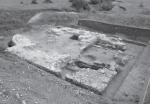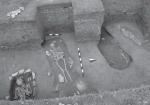Summary (English)
ARCHAEOLOGICAL EXPLORATIONS NEAR THE VILLAGE OF NOVOSEL (Mariela Inkova – inkovam@mail.bg, Ivailo Kanev) A cross-in-square church with an apse, a nave and a narthex, was discovered, 8.70 m long and 6.10 m wide. The foundation of the church consists of two courses of stones. The walls are 1 – 1.10 m wide and are constructed of uneven stones bonded with mortar. An ashlar with incised cross was incorporated into the southern wall. A capital from a column with floral decoration was found. The floor was paved with bricks. A layer of charcoal and pieces of burned wood testify to a fire. The finds include a clasp of a book, a lead cross, a processional iron cross, iron rivets, staples, wedges, sherds of the 10th – 15th centuries, sgraffito pottery of the 13th – 14th centuries. There is a tomb built of stone slabs at the northern side of the narthex. The inner walls of the burial chamber were plastered with mortar. Two burials, probably belonging to the donors of the church, were explored inside the tomb. During the secondary burial, the bones of the first deceased were collected and placed on the left leg of the second one. The small size of the building, the absence of Prothesis and Diaconicon and the cemetery situated around the church testify that it was used as a cemetery chapel. Sixty-eight Christian graves were explored. The burial pits are 1 – 1.40 m deep. Traces of wooden boards were documented over some of the pits. The arms of the deceased were folded and placed on the chest, on the abdomen, or on the pelvis. Three graves contained double burials of two children and of mother and child. Traces of funerary feasts were documented. A silver coin of Sultan Murad II (1421 – 1451) was found in grave No. 6, silver coins of Sultan Mehmed II (1451 – 1481) were found in graves Nos. 19, 34 and 44, and beads, finger-rings and an earring of the 10th – 11th centuries were found in graves Nos. 30, 36, 64 and 67.
- Mariela Inkova - National Museum of History
- Ivailo Kanev - National Museum of History
Director
Team
Research Body
- National Museum of History






![Download [PDF]](/excavation/skins/fasti/images/results/download_sml.png)
